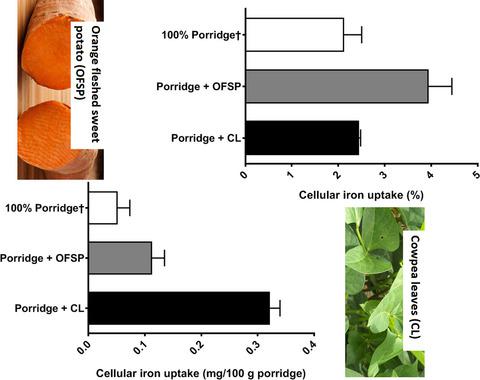当前位置:
X-MOL 学术
›
Food Sci. Nutr.
›
论文详情
Our official English website, www.x-mol.net, welcomes your feedback! (Note: you will need to create a separate account there.)
Potential of food-to-food fortification with cowpea leaves and orange-fleshed sweet potato, in combination with conventional fortification, to improve the cellular uptake of iron and zinc from ready-to-eat maize porridges.
Food Science & Nutrition ( IF 3.9 ) Pub Date : 2020-05-18 , DOI: 10.1002/fsn3.1576 Johanita Kruger 1, 2
Food Science & Nutrition ( IF 3.9 ) Pub Date : 2020-05-18 , DOI: 10.1002/fsn3.1576 Johanita Kruger 1, 2
Affiliation

|
An emerging tool in the fight against the high prevalence of micronutrient deficiencies in sub‐Saharan Africa is the production of nutritionally enhanced staple food products, through food‐to‐food fortification with micronutrient‐dense fruits and vegetables. This study investigated food‐to‐food fortification with cowpea leaves (CL) and orange‐fleshed sweet potato (OFSP) in combination with conventional micronutrient fortification and fermentation on the mineral and antinutrient contents and Caco‐2 cellular uptake of iron and zinc from ready‐to‐eat maize porridges. The amount of iron and zinc taken up from maize porridges (0.05 and 0.06 mg/100 g, db, respectively) was increased more after fortification with CL, compared to OFSP (0.32 and 0.23 mg/100 g, db versus. 0.11 and 0.04 mg/100 g, db, respectively). Despite the moderate cellular uptakes of iron and zinc from the CL fortified porridges (2.71% and 3.10%, respectively) compared to the OFSP fortified porridges (6.51% and 5.22%, respectively), the CL fortified porridges had much higher high iron and zinc contents (12.2–14.1 and 7.6–8.9 mg/100 g, db versus. 2.1–3.7 and 1.5–2.7 mg/100 g, db, respectively). This highlights the importance of increasing both the mineral content and bioavailability when fortifying a product. Even when a food product contains substantial antinutrients such as CL, if the mineral content and contents of bioavailability enhancers are high enough, the amounts of bioavailable iron and zinc can still be improved.
中文翻译:

cow豆叶和橙皮红薯在食物与食物之间的强化作用与常规强化作用相结合,可改善即食玉米粥对铁和锌的细胞吸收。
在撒哈拉以南非洲,与微量营养素缺乏症高发斗争的一种新兴工具是通过使用微量营养素密集的水果和蔬菜强化食物对食品的营养,生产主粮。这项研究调查了cow豆叶(CL)和橙皮甘薯(OFSP)与常规微量营养素强化和发酵相结合的食物对食物强化对矿物质和抗营养素含量以及现成的Caco-2细胞吸收铁和锌的作用食用玉米粥。与OFSP相比,用CL强化后,从玉米粥中吸收的铁和锌的量(分别为0.05和0.06 mg / 100 g,db)比OFSP分别增加(0.32和0.23 mg / 100 g,db与0.11和0.04)。毫克/ 100克,分贝)。尽管相比于OFSP强化粥(分别为6.51%和5.22%),CL强化粥中铁和锌的细胞摄取量适中(分别为2.71%和3.10%),但CL强化粥中的高铁和锌含量高得多含量(分别为12.2–14.1和7.6–8.9 mg / 100 g,分贝;分别为2.1–3.7和1.5–2.7 mg / 100 g,分贝)。这突出了在强化产品时增加矿物质含量和生物利用度的重要性。即使食品中含有大量的抗营养成分(如CL),如果矿物质含量和生物利用度增强剂的含量足够高,仍可以提高生物利用度的铁和锌的含量。CL强化粥的铁和锌含量高得多(分别为1.2.2–14.1和7.6–8.9 mg / 100 g,db,分别为2.1–3.7和1.5–2.7 mg / 100 g,db)。这突出了在强化产品时增加矿物质含量和生物利用度的重要性。即使食品中含有大量的抗营养剂(例如CL),如果矿物质含量和生物利用度增强剂的含量足够高,仍可以提高生物利用度的铁和锌的含量。CL强化粥的铁和锌含量高得多(分别为1.2.2–14.1和7.6–8.9 mg / 100 g,db,分别为2.1–3.7和1.5–2.7 mg / 100 g,db)。这突出了在强化产品时增加矿物质含量和生物利用度的重要性。即使食品中含有大量的抗营养剂(例如CL),如果矿物质含量和生物利用度增强剂的含量足够高,仍可以提高生物利用度的铁和锌的含量。
更新日期:2020-05-18
中文翻译:

cow豆叶和橙皮红薯在食物与食物之间的强化作用与常规强化作用相结合,可改善即食玉米粥对铁和锌的细胞吸收。
在撒哈拉以南非洲,与微量营养素缺乏症高发斗争的一种新兴工具是通过使用微量营养素密集的水果和蔬菜强化食物对食品的营养,生产主粮。这项研究调查了cow豆叶(CL)和橙皮甘薯(OFSP)与常规微量营养素强化和发酵相结合的食物对食物强化对矿物质和抗营养素含量以及现成的Caco-2细胞吸收铁和锌的作用食用玉米粥。与OFSP相比,用CL强化后,从玉米粥中吸收的铁和锌的量(分别为0.05和0.06 mg / 100 g,db)比OFSP分别增加(0.32和0.23 mg / 100 g,db与0.11和0.04)。毫克/ 100克,分贝)。尽管相比于OFSP强化粥(分别为6.51%和5.22%),CL强化粥中铁和锌的细胞摄取量适中(分别为2.71%和3.10%),但CL强化粥中的高铁和锌含量高得多含量(分别为12.2–14.1和7.6–8.9 mg / 100 g,分贝;分别为2.1–3.7和1.5–2.7 mg / 100 g,分贝)。这突出了在强化产品时增加矿物质含量和生物利用度的重要性。即使食品中含有大量的抗营养成分(如CL),如果矿物质含量和生物利用度增强剂的含量足够高,仍可以提高生物利用度的铁和锌的含量。CL强化粥的铁和锌含量高得多(分别为1.2.2–14.1和7.6–8.9 mg / 100 g,db,分别为2.1–3.7和1.5–2.7 mg / 100 g,db)。这突出了在强化产品时增加矿物质含量和生物利用度的重要性。即使食品中含有大量的抗营养剂(例如CL),如果矿物质含量和生物利用度增强剂的含量足够高,仍可以提高生物利用度的铁和锌的含量。CL强化粥的铁和锌含量高得多(分别为1.2.2–14.1和7.6–8.9 mg / 100 g,db,分别为2.1–3.7和1.5–2.7 mg / 100 g,db)。这突出了在强化产品时增加矿物质含量和生物利用度的重要性。即使食品中含有大量的抗营养剂(例如CL),如果矿物质含量和生物利用度增强剂的含量足够高,仍可以提高生物利用度的铁和锌的含量。


























 京公网安备 11010802027423号
京公网安备 11010802027423号